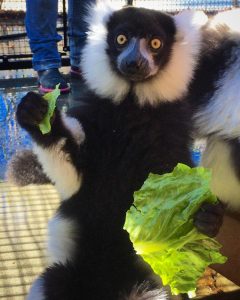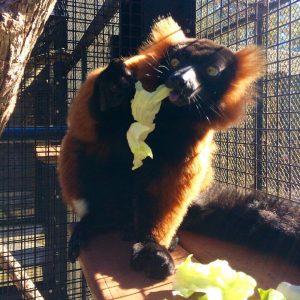The practical use and benefits of research
Hi, Duke Lemur Center blog reader! I’m Lydia, a DLC researcher and veteran tour guide. On tours, I’m often asked to explain how research at the DLC can actually help us conserve and care for these endangered animals. What follows here is an example of how, by working closely with our research, technician, conservation, and veterinary staff, research helps improve the welfare of our lemur population.
Importance of fiber and the gut microbiome for lemurs’ health
So, what’s my research? I study lemur food and poop.
More specifically, my good friend Erin McKenney and I study the community of bacteria that inhabit lemur guts, the so-called “gut microbiome.” Gut microbiomes are super important because they can digest the structure of fruits, vegetables, grains, and legumes, commonly known as “fiber.” Fiber goes undigested by lemurs until it hits their functional appendix, called a cecum, and colon. The cecum and colon are overloaded with beneficial microbes whose primary job is to turn fiber into nutrients, called short-chain fatty acids, that help keep lemurs healthy. How cool is that?
I should mention that fiber -> gut microbiome -> nutrient relationship isn’t limited to lemurs: Our gut microbiomes do the same for us!
For leaf-eaters like sifakas, the relationship between fiber and the gut microbiome is crucial. Without their microbes, sifakas could not extract enough energy from their leaves to survive.
But wait, this post comes with photos of ruffed lemurs eating lettuce… Right. Ruffed lemurs are the polar opposites of sifakas when it comes to diet. Whereas sifakas eat leaves and take 24 hours to pass their food as poop, ruffed lemurs are fruit eaters and need only 3 hours to digest meals. That’s because the sugar and fats in fruit are quickly absorbed by ruffed lemurs’ intestines, whereas leaves require lots of time to be turned into nutrients by sifakas.
A fiber boost for ruffed lemurs
However, from our Conservation Coordinator, Charlie Welch, I learned that the fruit that grows in Madagascar’s forests is very different from the fruit we have in the United States. Our fruit has been cultivated to be high in sugar and low in fiber, but wild fruits in Madagascar have thicker rinds and less pulp. Think of how little skin versus flesh an American apple holds. I’m primarily a sifaka specialist, but in all my research on fiber and sifaka guts, I started thinking that maybe our fruit eaters were the ones who could use a fiber boost. When Erin McKenney agreed with me, I knew I was on to something.
Our vets, Cathy Williams and Bobby Schopler, are both big fans of dietary fiber and are always looking for ways to get our lemurs to eat more of it. The problem for ruffed lemurs is, they don’t really care for fiber-rich foods! We’ve tried spinach, kale, collards, and local foliage, all with limited success. But, what about romaine? Romaine is a lighter leaf, so it’s less bitter. I wondered if romaine might be more palatable to our fruit lovers.
Cathy and Bobby, as well as our research manager Erin Ehmke, research technician Kay Welser, and technician supervisor Britt Keith were all on board. I found some nice-looking lettuce and technician Julie carefully washed it to make sure it was safe for our animals. Research truly takes a village at the DLC.
“Voracious consumption” – and happy lemurs!
The only words I have to describe what happened next are “voracious consumption.” I started with Astro and Cosmo, young twins with a curious streak that I thought would lead to them trying the lettuce. What I wasn’t prepared for was mom and dad, Halley and Ravo, also wolfing it down! And then there were the adult triplets, Carme, Puck, and Titan, who squabbled over the crunchy bits. Herschel wins the award for most skeptical, whereas Arche wins the award for most comical after his sister (accidentally?) hit him in the face with a leaf. And geriatric Comet and Galaxy, both wild-caught in the 1980s in Madagascar, couldn’t get enough! Both Comet and Galaxy have some stiff joints these days, but upon seeing the leaves, Galaxy “sprang” from her favorite basket to munch them down. I think Comet exuberantly consumed at least half-a-head of romaine by himself with a satisfied look on his face that clearly said, “Finally!”
Three years ago, I set out on my dissertation journey to better understand lemur nutrition, health, and the gut microbiome. I didn’t know if my work would produce tangible benefits for the lemurs, and I had no idea that studying sifaka poop could lead to lettuce for ruffed lemurs! I knew I wanted to make a difference in our lemurs’ lives, but research is not always goal-oriented and sometimes the applied value comes only after new information is revealed. I’m humbled to think that this week I made a difference in the life of an aging red ruffed lemur who, for the past 30 years, has been on the lookout for a good salad!
Further reading
To learn more about lemurs’ gut microbiome, see Erin McKenney and Anne Yoder’s paper on gut microbiomes in the DLC’s lemurs: Patterns of Gut Bacterial Colonization in Three Primate Species. Erin compares ruffed lemurs to ring-tails and sifakas – super interesting!
To learn more about the evolutionary history of lemurs’ diets, how fruit-eating lemurs are critical to the long-term survival of fruit-bearing plants on Madagascar, and “how this information can inform conservation initiatives targeting the protection and and restoration of these vulnerable ecosystems,” see Implications of lemuriform extinctions for the Malagasy flora (Federman et al., 2016). Co-authors include Anne Yoder, Director of the Duke Lemur Center.



